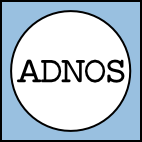UV-Dryer
Optimum instead of maximum: Intelligent UV dryer and H-UV dreyer systems with automatic UV dimmer
The features of the ADNOS intelligent UV-dryer system:
- Safe drying at any speed
- Simple operation
- ADNOS plug-in system allows for short make-ready times
- Hassle-free installation in printing presses
- low thermal load on printed material and machine
- Compact design
- Each UV readiator can be controlled individually
- Gap usage in stand-by mode with indication of current output level for sheet and metal plate drying
- Energy save up to 50%
- Drying on web-fed presses also without cooling cylinder due to guaranteed low material temperature
- Extremely short start-up and cooling-down time (approx. 1 minute)
The function
In the course of the printing process the freshly printed shee is transported through the UV radiation zone. The microprocessor in the UV dryer measures the printing speed, senses the position and length of the sheet and switches each lamp from the “idle” output level (20% of rated output) to exactly the required output level in approx. 5 ms. Print stock formats whichdeviate from the largest possbile format are also detected by the machine and evaluatedby the microprocessor. For example, if a print format is used which is55 mm shorter than the standard, the microprocessor swithces the UV lamp back to the “idle” output level 55 mm earlier.
Why UV dimmer?
You know from practical experience: no two printing jobs are alike. Paper quality varies as much as the properties of the inks and varnishes, the respective printing speed and the sheet size. A conventional unflexible UV-system which does not allow to change the settings and to adapt it to the varying job conditions therefore makes no sense. Adhesive foils, for instance, change their adhesive properties if the UV emission is not adapted properly, whereas other products may shrink due to excessive heat from the UV-lamps and cause alignment problems in the press as a result of which the qualitiy of the finished product is jeopardized. The automatic UV dimmer is therefore the only acceptable means to achieve an optimized printing result. The intelligent ADNOS UV-dryers adapt to all the above variables.
What does it mean: stand-by output and gap usage?
 It’s quite simple: the UV lamps should emit UV radiation at their normal level only if there is some product to absorb the radiation, whereas inbetween – for instance at the gap between 2 sheets or at ink- or varnish-free areas on webs – the intelligent ADNOS UV-dryer “dims” (reduces) the UV-radiation emitted by the lamps to only 20% of their normal output, i.e. to stand-by output level. Thanks to the automatic sheet size detector on ADNOS systems, this works reliably also with short sheet sizes. Switching back to normal, preset production UV-output is done within miliseconds and with an accuracy of a fraction of a millimeter. The immediate advantage for you is by far less heat inside the machine, because it is almost exclusively the printed material which is subjected to the UV radiation and not the counter pressure cylinder.
It’s quite simple: the UV lamps should emit UV radiation at their normal level only if there is some product to absorb the radiation, whereas inbetween – for instance at the gap between 2 sheets or at ink- or varnish-free areas on webs – the intelligent ADNOS UV-dryer “dims” (reduces) the UV-radiation emitted by the lamps to only 20% of their normal output, i.e. to stand-by output level. Thanks to the automatic sheet size detector on ADNOS systems, this works reliably also with short sheet sizes. Switching back to normal, preset production UV-output is done within miliseconds and with an accuracy of a fraction of a millimeter. The immediate advantage for you is by far less heat inside the machine, because it is almost exclusively the printed material which is subjected to the UV radiation and not the counter pressure cylinder.
What does the computer?
The computer is the electronic heart and monitors all important components of both, UV-dryer and printing press and uses those data to control the UV dimmer and thus achieves an optimized energy output of the UV lamps. Additional information such as ink distribution can be entered into the computer or be set manually.
Why is there no water cooling for the ADNOS dryer?
First of all, water cooling is not a sign of quality, but often a necessary evil. ADNOS intelligent UV-dryers do not need this. Normal air cooling is quite sufficient. For one, this is due to the unique UV dimming which avoids unnecessary heat. Furthermore, the reflectors used in the ADNOS UV dryers are of such high quality that they reflect the radiation almost completely. The absence of an extensive water cooling makes the operation of an ADNOS dryer particularly easy – the exchange of lamps or relocation of of entire lamp housings is done fast be the printer himself. Lastly, the air cooling allows the UV dryer to be of particulary compact design, which allows for UV drying also on small printing presses where this does not seem possible on first glance.
When is it necessary to use inert gas UV systems?
Whenever particularly sensitive materials need to be coated with low reacting UV substrates. These substrates, when hardened in a normal oxygen environment, would require a huge amount of radiation energy which would damage the printed material. ADNOS has designed special inert gas UV-dryers, which harden UV-inks, -varnishes or coatings under protective inert gas with considerably less energy and thus prevent any damage.
How much energy does the ADNOS intelligent UV and H-UV dryer with UV dimmer save?
Up to 50 % ! We will be happy to work out for you exactly how much energy you can save based on your particular production conditions.
